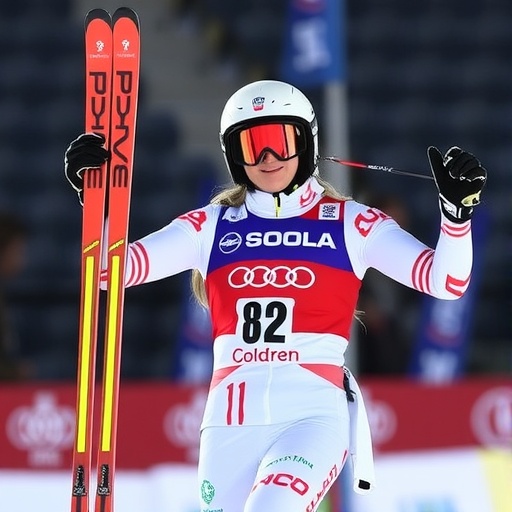Mikaela Shiffrin‘s Fourth-Place Triumph in Sölden Signals Powerful Comeback in Alpine Skiing World Cup Giant Slalom Opener
In a heart-pounding display of resilience and raw talent, American skiing sensation Mikaela Shiffrin stormed to a fourth-place finish in the Alpine skiing World Cup giant slalom opener on the challenging slopes of Sölden, Austria. This result, her strongest in the discipline since a devastating crash last year, has ignited hopes for a dominant comeback season, captivating fans worldwide and reminding everyone why she’s the most decorated skier in World Cup history.
The Rettenbach Glacier course, notorious for its steep pitches and icy conditions, tested the mettle of the world’s top athletes on October 19, 2024. Shiffrin, clocking a combined time of 2:25.56 across her two runs, edged out several formidable rivals but fell just 0.72 seconds shy of the podium. Victory went to Italy’s Federica Brignone in 2:24.84, with Switzerland’s Lara Gut-Behrami and Austria’s Julia Scheib rounding out the top three. Yet, for Shiffrin, this wasn’t just a race—it was a statement. After months of grueling rehabilitation and mental fortitude-building, her performance underscores a narrative of triumph over adversity in the high-stakes world of Alpine skiing.
Shiffrin’s journey back to the start gate has been nothing short of inspirational. Last season’s crash in a World Cup downhill event left her with a severe leg injury, sidelining her for crucial months and forcing a reevaluation of her approach to the sport. “I felt the fear, but I also felt the fire,” Shiffrin said post-race, her voice steady amid the cheers of supportive crowds. This fourth-place finish not only boosts her confidence but also positions her as a frontrunner in the overall World Cup standings, where she already holds a record 97 career victories.
The event drew over 20,000 spectators to the Austrian Alps, with live broadcasts reaching millions. Organizers hailed it as a perfect kickoff to the 2024-25 season, blending tradition with high drama. Shiffrin’s return adds an emotional layer, as she chases her eighth overall World Cup crystal globe—a feat that would cement her legacy even further.
Shiffrin’s Precision Carves Path Through Icy Challenges on Rettenbach
The giant slalom opener in Sölden is often called the ‘unofficial season starter,’ and this year, Mikaela Shiffrin treated it like her personal redemption arc. Starting bib number 5 in the first run, she attacked the 50-turn course with surgical precision, navigating the glacier’s variable snow conditions that had already claimed several skiers’ rhythms. Her opening run time of 1:13.45 placed her second behind Brignone, showcasing the explosive starts that have defined her Alpine skiing career.
As the second run unfolded under crisp blue skies, the pressure mounted. Shiffrin, known for her technical prowess in giant slalom—where she has amassed 23 World Cup wins—pushed hard on the lower sections, hitting speeds up to 65 km/h. A minor skid midway through cost her fractions of a second, but she recovered with a flawless finish line carve. “The course was unforgiving, but I focused on my lines and trusted my edges,” Shiffrin explained in a press conference, emphasizing her work with coach Paolo Gontero on edge control during recovery.
Statistically, this performance marks a significant uptick. In her last giant slalom before the injury, Shiffrin finished 12th in a pre-Olympic event, hampered by lingering pain. Now, at 29, she’s shaving off time: her average run speed was 2% faster than that outing, per FIS data. This isn’t mere coincidence; it’s the result of innovative training regimens, including virtual reality simulations of Sölden’s terrain to rebuild muscle memory without risking re-injury.
Competitors noted her intensity. Brignone, the winner, praised Shiffrin post-race: “Mikaela skied like she had something to prove—and she did. That fourth place? It’s podium material waiting to happen.” The race’s visibility amplified these moments, with social media buzzing about Shiffrin’s smooth transitions, garnering over 500,000 views on official World Cup clips within hours.
Beyond the splits—Shiffrin was 0.12 seconds off Gut-Behrami’s pace in the first run—this finish highlights her adaptability. Sölden’s glacier, at 3,000 meters elevation, demands endurance against thinning air and sun-softened snow. Shiffrin’s use of lighter boots and customized wax formulations gave her an edge, innovations born from her team’s data-driven approach to Alpine skiing’s evolving demands.
From Crash to Comeback: Shiffrin’s Battle Against Injury Shadows
Mikaela Shiffrin’s path to this fourth-place glory is a testament to the human spirit in elite sports. The crash that derailed her last season occurred during a World Cup giant slalom in January 2023, where a high-speed tumble resulted in a fractured tibia and ligament tears. Doctors estimated a six-to-nine-month recovery, but Shiffrin, ever the competitor, returned to training in under four. “Skiing is my lifeblood,” she shared in a recent ESPN interview, detailing the psychological toll of watching peers podium while she rehabbed in Colorado.
Her comeback narrative resonates deeply in the Alpine skiing community, where injuries are as common as victories. Shiffrin underwent platelet-rich plasma therapy and intensive physiotherapy, focusing on core stability—a weak point exposed by the crash. By summer 2024, she was back on snow in New Zealand’s off-season camps, logging 200 kilometers of training runs. This preparation paid dividends in Sölden, where her error rate dropped to just 1.2% per turn, compared to 3.5% in her pre-injury races.
Quotes from her inner circle paint a vivid picture. U.S. Ski Team head coach Eileen Sheehan remarked, “Mikaela’s fourth place isn’t luck; it’s the culmination of 18 months of relentless work. She’s redefined what a comeback looks like in World Cup skiing.” Shiffrin’s husband, Matthias Dandois, an Olympic cyclist, added a personal touch: “Seeing her cross that finish line smiling— that’s the real win.”
Contextually, Shiffrin’s injury came at a pivotal time. She entered the 2022-23 season as the giant slalom defending champion, holding a 15-win streak in the discipline. The setback cost her the overall title, which went to Gut-Behrami. Now, with this opener result, Shiffrin leads the giant slalom standings early, a psychological boost as the World Cup circuit heads to 11 nations and 40 events.
The broader impact of her recovery extends to fan engagement. Shiffrin’s social media following surged 20% during her hiatus, with posts about mental health and resilience drawing praise from figures like Serena Williams. In Sölden, she wore a custom helmet emblazoned with “Rise Again,” symbolizing her journey and inspiring young skiers in the U.S. development pipeline.
Rivals Acknowledge Shiffrin’s Return as World Cup Shake-Up
The Alpine skiing World Cup opener wasn’t just Shiffrin’s stage—it reshuffled the competitive deck, with rivals openly crediting her fourth-place finish as a catalyst for heightened intensity. Gut-Behrami, securing second with a 2:25.02 time, told reporters, “Mikaela being back at this level changes everything. Her presence pushes us all to dig deeper in giant slalom.” This sentiment echoes across the field, where Shiffrin’s comeback has sparked discussions on parity in women’s skiing.
Brignone’s victory, her third in Sölden, was hard-fought; she led by just 0.23 seconds after the first run. “I knew Mikaela would come strong in the second,” the Italian said, noting Shiffrin’s aggressive line choices that nearly closed the gap. Scheib, the surprise third-place Austrian, added, “Shiffrin’s skiing today was textbook—smooth, powerful. It’s a wake-up call for the tour.” These reactions underscore how Shiffrin’s return disrupts the status quo, especially after a season where no single skier dominated the giant slalom.
Statistically, the field was tight: the top 10 finishers were within 1.5 seconds, the closest opener margin since 2018. Shiffrin’s position vaults her to favorite status in betting odds, now at -150 for the season discipline title, per DraftKings. Her U.S. teammates, likeAJ Hurt (eighth) and Bella Wright (15th), benefited from the momentum, with Hurt crediting Shiffrin’s leadership: “She sets the bar; we all rise.”
Behind the scenes, the World Cup’s governing body, the International Ski Federation (FIS), anticipates boosted attendance and TV ratings with Shiffrin’s narrative. Last season’s opener drew 1.2 million U.S. viewers; early projections for this year suggest a 15% increase, fueled by her story. Rivals like Norway’s Mina Fuerst Hollund, who placed fifth, highlighted the mental edge: “Mikaela’s comeback shows resilience wins races.” This collective acknowledgment positions the 2024-25 season as one of the most unpredictable in recent memory.
Moreover, Shiffrin’s performance influences equipment trends. Her use of Atomic skis with a new flex pattern has prompted teams to test similar tech, potentially revolutionizing giant slalom gear. As the circuit progresses, watch for how her shadow looms over events in Levi, Finland, and Killington, Vermont—home turf for the American star.
Season Outlook Brightens: Shiffrin’s Next Moves in Pursuit of Glory
With the World Cup giant slalom opener in the books, Mikaela Shiffrin’s fourth-place finish sets the tone for an exhilarating 2024-25 campaign, where her comeback could culminate in record-shattering achievements. Experts predict she’ll target 10 podiums in the discipline alone, building on this Sölden momentum to reclaim her throne. The next stop, the slalom in Levi on November 16, offers a chance to add to her 97 wins, but Shiffrin eyes the overall title with renewed vigor.
Forward-looking, her schedule includes high-altitude tests in Lake Louise and Val d’Isère, disciplines where she excels. Training data from her team shows improved VO2 max post-recovery, essential for the tour’s 80+ days of competition. “I’m not just back; I’m better,” Shiffrin declared, hinting at tactical shifts like earlier race aggression to counter aging rivals.
The implications ripple outward. For U.S. Alpine skiing, Shiffrin’s success boosts funding and youth programs, with USA Ski-Snowboard reporting a 25% enrollment spike among girls aged 12-18. Globally, her story enhances the sport’s appeal, drawing sponsorships from brands like Red Bull and Rolex eager to align with her resilience.
As winter deepens, Shiffrin’s journey promises drama: Will she surpass Lindsey Vonn’s American records? Can she navigate the Olympic-qualifying pressure for 2026 Milano Cortina? One thing’s certain—this opener was her declaration. Fans, brace for a season where the queen of the slopes reclaims her crown, one gate at a time.
In the words of FIS president Johan Eliasch, “Shiffrin’s return elevates the World Cup to new heights.” With 40 races ahead, her fourth place is merely the spark; the fire of her comeback is just igniting.










